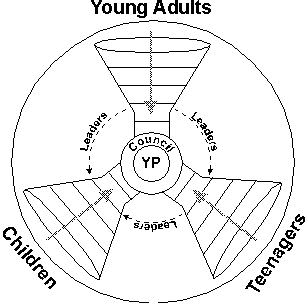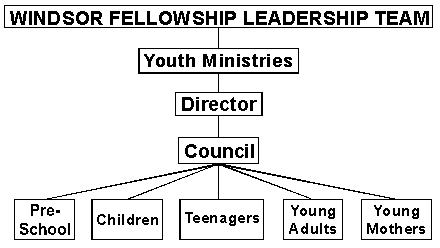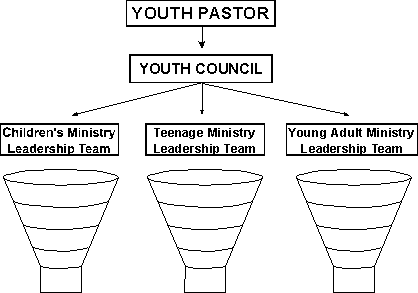
In terms of youth ministry, which includes the children, teenage and young adults groups, it is important to introduce a Youth Council. This would be made up of representatives from each of the three age group ministries, under the oversight of a youth pastor, or youth ministry co-ordinator. The Council would also include any youth specialists within the body, such as social workers, counselors, parents and a few concerned adults. The functions of this council are: (1) oversee the philosophy of ministry that has been adopted by the youth ministry, (2) to ensure that the ministries between the age groups are coordinated so that the transition of youth between groups are smooth, (3) to provide a unified sense of purpose and direction in terms of focus and curriculum (not necessarily studying the same material but, for example, ensuring that children are being trained for adolescence before they get there), (4) to organize combined events that brings the different groups together, (5) to share resources between the groups including programme, physical and and human resources, and (6) to handle special counselling situations that may arise and which require the involvement of various age group leaders.
To conceptualize how the Council works, picture three funnels leading into a center circle with the pool of humanity level far from the center (for each additional age group that is brought online another funnel would be added). See the following diagram:

The diagram shows the important role that leaders play in different age groups - especially in the young age group. For example, some of the teenagers can be involved in the leadership of the children's group depending on their spiritual maturity and gifting. The same happens with young adults in the teenage group (this implies that we need middle-aged adults to be involved in the young adults group). I am convinced that each generation should be reaching back to pass on what they have learnt to the generation following behind them - this is the heart of Paul's discipleship by multiplication emphasis in 2 Timothy 2:2: "And the things you have heard me say in the presence of many witnesses entrust to reliable men who will also be qualified to teach others" (NIV).
The diagram also shows the importance of identifying a youth ministry director (co-ordinator, youth pastor, etc.). In order to ensure effective co-ordination of all ministry among youth in a local church, the leadership should consider appointing, either in a part time or a full-time capacity, a youth ministry director. The youth director has the following responsibilities: (1) Consult - to develop each age-specific ministry according to the commitment level philosophy of ministry; (2) Coordinate - to ensure continuity between the various ministries; (3) Care - to shepherd the leaders of the various ministries; and (4) Communicate - to keep the church aware of what is happening in the youth minstry.
The place of the council within the overall church structure is shown in the following diagram:

The relations of each age group to the council is shown in the following diagram:

Return to Model of Youth Ministry